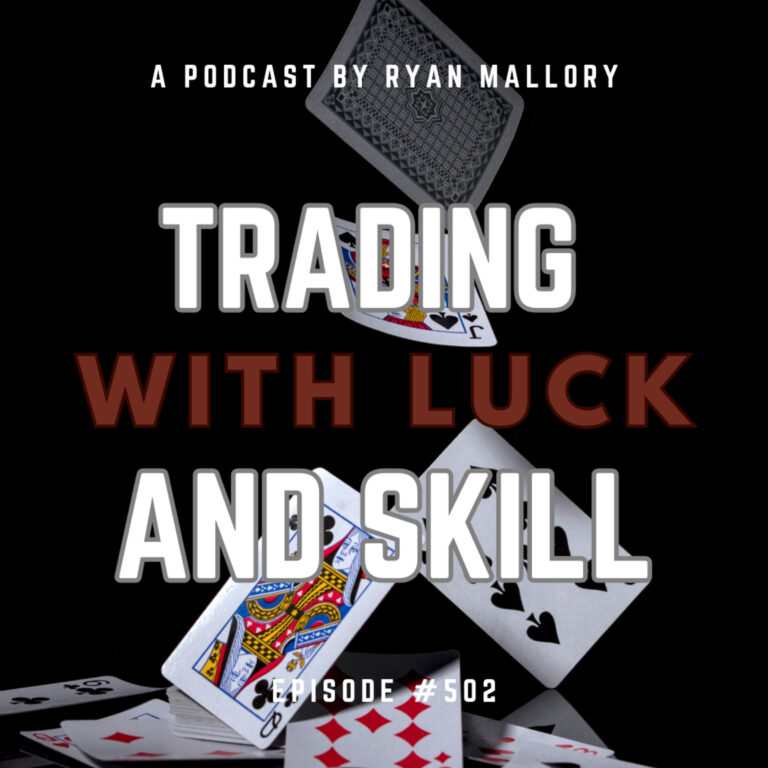How to Spot Bull Flag Patterns for Profitable Trading
Are you looking to improve your profitability and swing trading results by learning how to spot and trade bull flag patterns? Bull flag patterns are one of the most reliable and profitable chart patterns for swing traders. For me personally, it is my favorite continuation pattern. In this post, you’ll learn exactly what bull flags are, how to identify them, and a simple strategy for trading them. We’ll look at real examples of successful bull flag trades as well as a couple that didn’t work out.
What is a Bull Flag Pattern?
A bull flag is a continuation pattern that forms when a stock is in a strong uptrend. It gets its name because it looks like a flag on a pole. The pole is the initial sharp price rise and the flag is a period of consolidation when the stock moves sideways or drifts lower in a narrow range. This consolidation forms a rectangle shape, with the top of the rectangle acting as resistance and the bottom as support. The rectangle tilts downward slightly as the price drifts lower over time.
Here are the defining characteristics of a bull flag pattern:
- Occurs within a sharp uptrend
- Price rises sharply (the pole), then moves sideways or drifts lower (the flag) – usually on light volume.
- The flag is a tight rectangle tilting slightly downward (think a flag waving on a flag pole).
- Volume usually declines during consolidation
- Breakout occurs in the direction of the initial trend and is often accompanied by a volume surge, light volume increases the probabilities of a false breakout.
The psychology behind the bull flag is that after a big price rise, the stock becomes overbought and early buyers start taking profits. This profit-taking pushes the price sideways or lower, forming the flag. But the overall uptrend remains intact and new buyers eventually jump in and drive the price higher. The depth of the flag is typically around 1/3 to 1/2 the size of the initial flagpole. Ideally though, I prefer it to be a third or less.
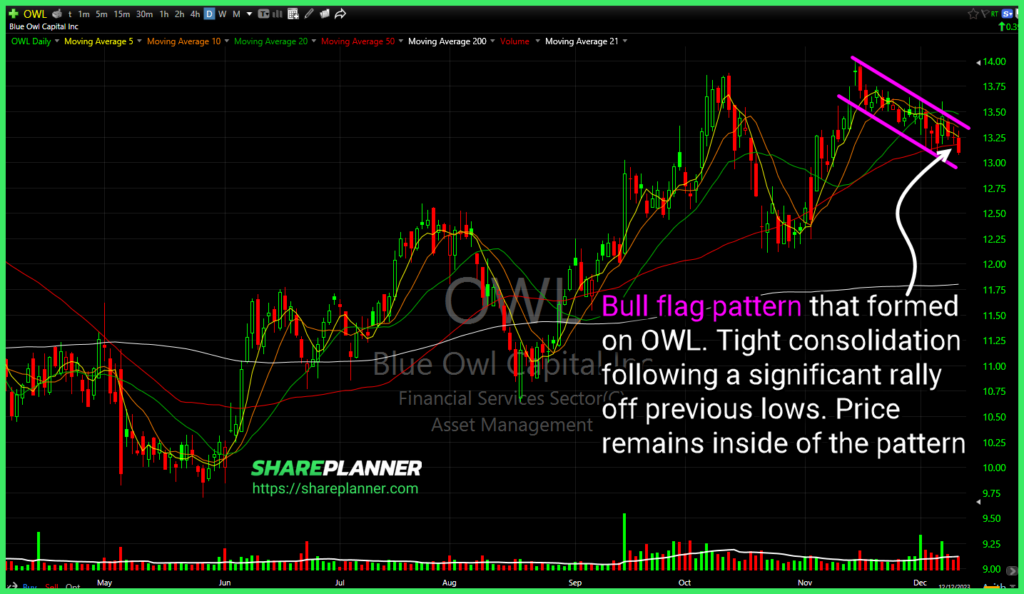
On the second chart, you can see how this swing trade was able to play out successfully, from the entry price, to the exit price.
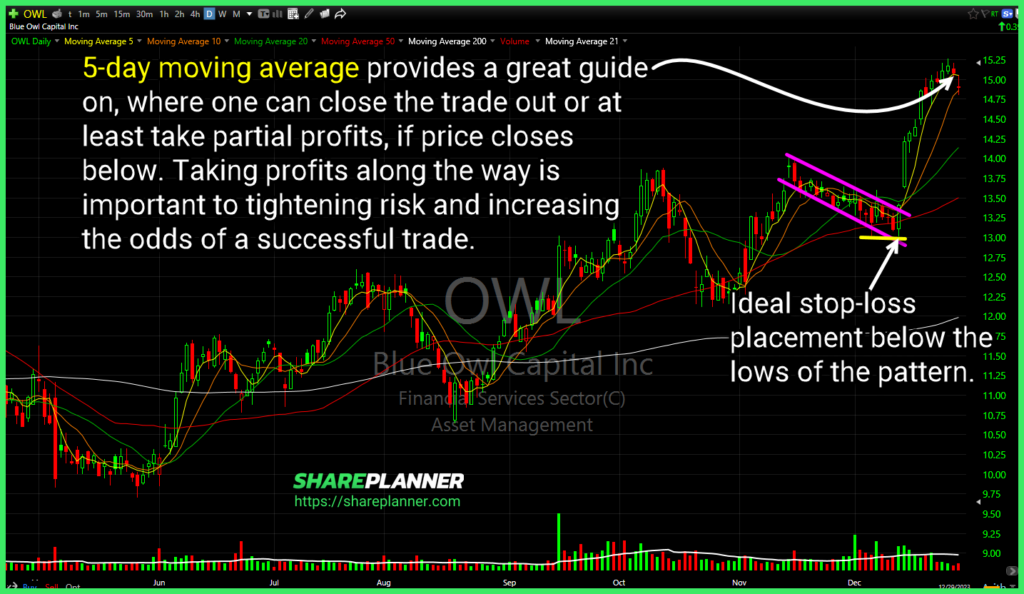
How to Trade Bull Flag Patterns There are a few different ways to trade bull flags, but here is a simple and effective approach:
- Identify a strong uptrend and wait for a bull flag to form. The initial flagpole should be at least a 45 degree angle in its ascent.
- Wait for the price to break out above the top of the flag rectangle. This is your buy signal.
- Place a stop loss just below the low of the flag. If the breakout fails, you’ll get stopped out for a small loss.
- Take partial profits at a 1:1 reward/risk and trail your stop to breakeven. Let the remainder ride.
- Take more profits at 2:1, 3:1, etc. Trail your stop to lock in gains.
This simple strategy allows you to capture quick profits if the trend sharply resumes, while also letting winners run in case of a very big move. The key is to keep your risk small and always use a stop loss.
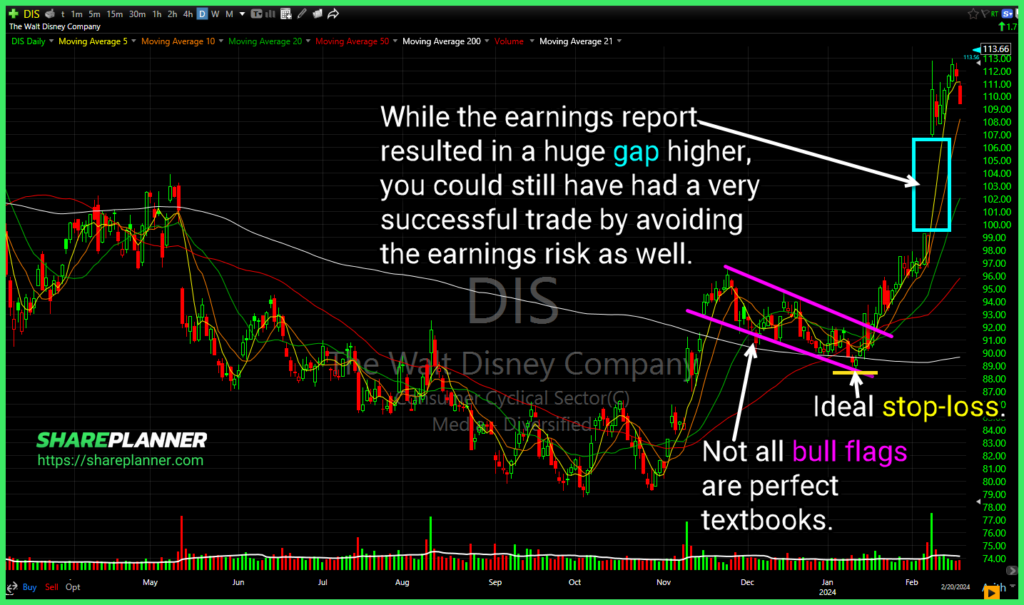
What to watch out for: While bull flags have a high success rate, not every pattern will result in a successful trade. Here are a couple things to watch out for:
- The flagpole is too short – The initial spike should be nearly vertical. If it’s too choppy or angled, it may not be a true bull flag.
- The flag is too big compared to the pole – Flags that are more than about half the size of the pole often fail.
- No volume spike on breakout – The breakout above the flag should come with a notable rise in volume. No volume surge is a warning sign.
- Nearby resistance – Make sure there is no significant resistance from earlier price action just above the bull flag. The stock needs room to run.
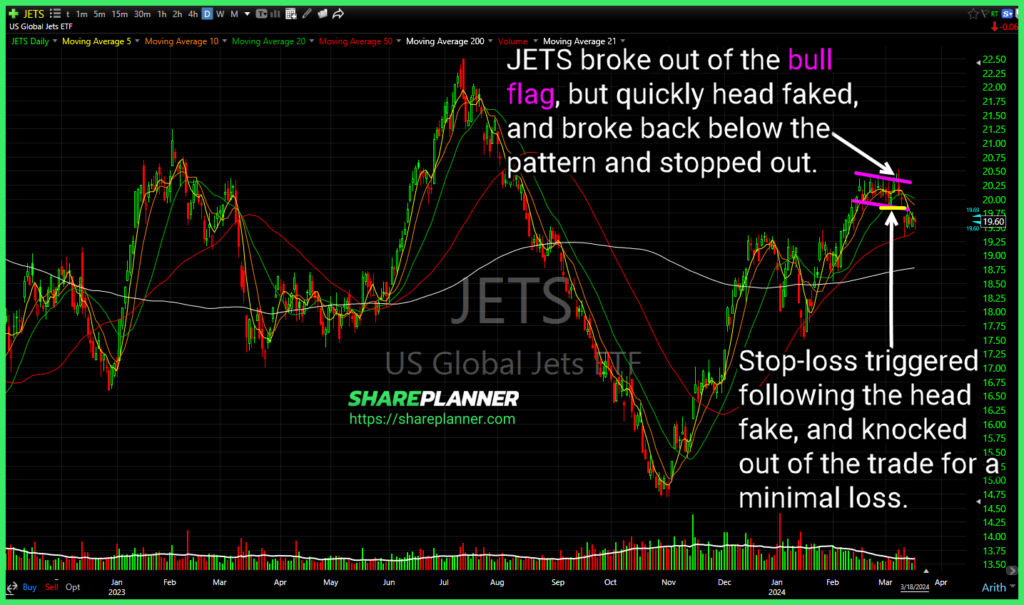
Here are a few final tips to help you profitably trade bull flag patterns:
- Be patient and wait for the setup – Don’t chase stocks, wait for clear bull flags to form.
- Trade in the direction of the overall market trend – Bull flags are most reliable when the broader market is also trending up.
- Stick to stocks with ample liquidity – Avoid thinly traded stocks to minimize slippage.
- Always manage the risk on your trade and know exactly where you’ll get out at if the trade goes against you. Proper position sizing is crucial for long-term success.
By following this simple strategy and keeping these tips in mind, you’ll be well on your way to harnessing the profit potential of bull flag patterns. No pattern works 100% of the time, but bull flags are one of the most consistent for swing traders.
Conclusion
Bull flag patterns provide reliable trading opportunities for swing traders. The key is to wait patiently for the right setups, control your risk, and stick to your strategy. By studying examples of successful bull flag trades as well as those that didn’t work out, you can learn to identify the highest probability setups. With practice and discipline, you can become an expert at profitably trading these powerful patterns.
Become part of the Trading Block and get my trades, and learn how I manage them for consistent profits. With your subscription you will get my real-time trade setups via Discord, Whatsapp and email, as well as become part of an incredibly helpful and knowledgeable community of traders to grow and learn with. If you’re not sure it is for you, don’t worry, because you get a Free 7-Day Trial. So Sign Up Today!

Welcome to Swing Trading the Stock Market Podcast!
I want you to become a better trader, and you know what? You absolutely can!
Commit these three rules to memory and to your trading:
#1: Manage the RISK ALWAYS!
#2: Keep the Losses Small
#3: Do #1 & #2 and the profits will take care of themselves.
That’s right, successful swing-trading is about managing the risk, and with Swing Trading the Stock Market podcast, I encourage you to email me (ryan@shareplanner.com) your questions, and there’s a good chance I’ll make a future podcast out of your stock market related question.
Is it better to be lucky or skillful when it comes to being a good trader? I would argue you can have it both ways, but it requires that skill manages the luck, and at times when luck is simply against you too.
Be sure to check out my Swing-Trading offering through SharePlanner that goes hand-in-hand with my podcast, offering all of the research, charts and technical analysis on the stock market and individual stocks, not to mention my personal watch-lists, reviews and regular updates on the most popular stocks, including the all-important big tech stocks. Check it out now at: https://www.shareplanner.com/premium-plans
📈 START SWING-TRADING WITH ME! 📈
Click here to subscribe: https://shareplanner.com/tradingblock
— — — — — — — — —
💻 STOCK MARKET TRAINING COURSES 💻
Click here for all of my training courses: https://www.shareplanner.com/trading-academy
– The A-Z of the Self-Made Trader –https://www.shareplanner.com/the-a-z-of-the-self-made-trader
– The Winning Watch-List — https://www.shareplanner.com/winning-watchlist
– Patterns to Profits — https://www.shareplanner.com/patterns-to-profits
– Get 1-on-1 Coaching — https://www.shareplanner.com/coaching
— — — — — — — — —
❤️ SUBSCRIBE TO MY YOUTUBE CHANNEL 📺
Click here to subscribe: https://www.youtube.com/shareplanner?sub_confirmation=1
🎧 LISTEN TO MY PODCAST 🎵
Click here to listen to my podcast: https://open.spotify.com/show/5Nn7MhTB9HJSyQ0C6bMKXI
— — — — — — — — —
💰 FREE RESOURCES 💰
— — — — — — — — —
🛠 TOOLS OF THE TRADE 🛠
Software I use (TC2000): https://bit.ly/2HBdnBm
— — — — — — — — —
📱 FOLLOW SHAREPLANNER ON SOCIAL MEDIA 📱
*Disclaimer: Ryan Mallory is not a financial adviser and this podcast is for entertainment purposes only. Consult your financial adviser before making any decisions.
